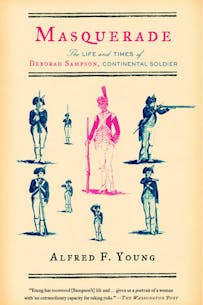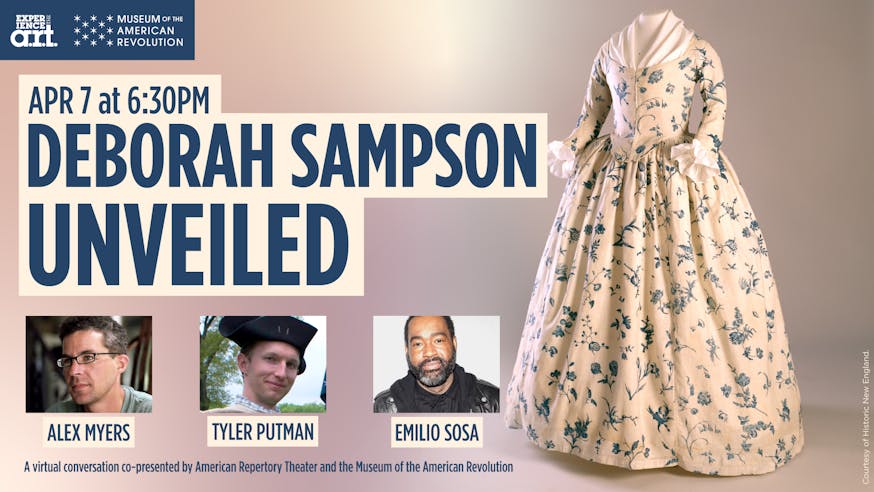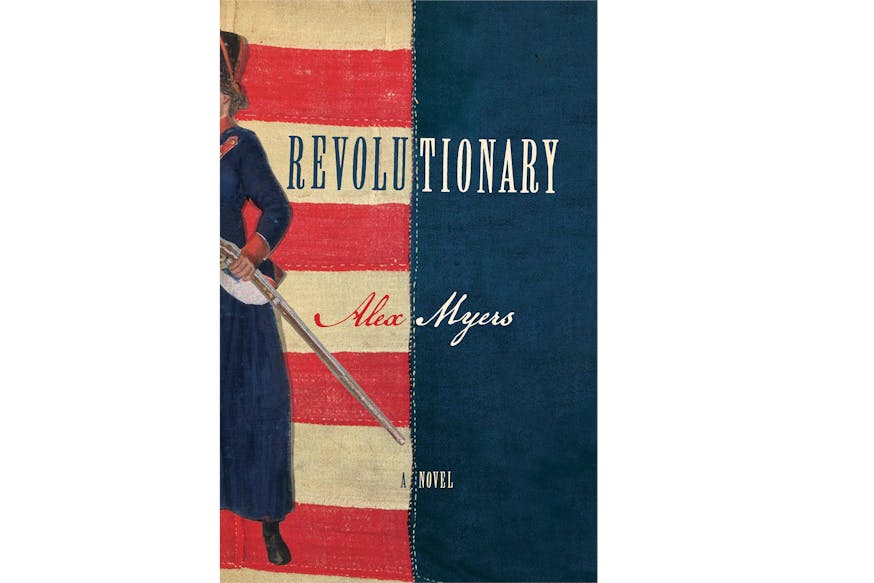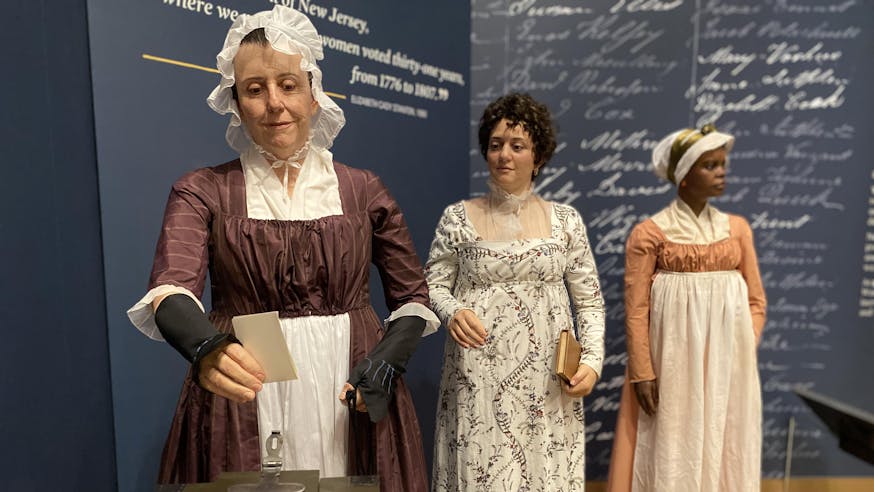Read the Revolution
Masquerade
April 6, 2021
Purchase the book from Penguin Random House.
In his 2005 book Masquerade: The Life and Times of Deborah Sampson, Continental Soldier, late historian Alfred F. Young documents the known details of Sampson’s life and investigates aspects of her story that remain mysterious. Born in 1760, Sampson was a Massachusetts woman who disguised herself as a man to enlist in the Continental Army. After the war, she spent years farming, weaving, and teaching before she married Benjamin Gannett, Jr., in 1785.
Young’s biography also addresses the complicated relationship between Sampson and her first biographer, Herman Mann, who interviewed Sampson to write and publish The Female Review in 1797 and encouraged Sampson’s public lecture tour in the early 1800s. To what degree did Sampson advocate for herself and fashion her own story, most often told by men, including fellow Massachusetts native and Continental Army corporal, Abner Weston, whose diary referencing Sampson was recently acquired by the Museum? How did Sampson live parts of her life as a “masquerade,” wearing clothing as an act to mislead or educate people about her own history? What did she think about the uniforms she wore, or about the printed blue-and-white floral wedding dress that is one of the only surviving objects that she once owned?
In this excerpt, Young examines Sampson’s agency in portraying herself at various stages in her life and the role that her clothing played in performing gender.
Excerpt
The threads that run through Sampson's life, for all the elusiveness of the record, are so vivid that they are not hard to weave into patterns. The decisions she made were always within the constraints of class as well as gender. She was, indeed, in her biographer's words, a young woman "of low birth and station" who belonged to "the female yeomanry," and she stayed so. Beginning life as an unfree servant, close to the bottom of rural society in a small New England farming town, she was freed from the burdens of labor in a farm household only when she became a weaver, a teacher, and a soldier, and later, after she became a farm housewife, only when she left town for her lecture tour or was laid up in illness. She stayed poor; her pension was a pittance, and she never was awarded the lump-sum back payment that might have lifted her family to prosperity. She was, in today's language, a poor rural farm woman, albeit one with aspirations for gentility.
She launched her transgressions, however, after she became a skilled weaver and a teacher, both androgynous trades. Her status in early American society was unusual: she was a free single woman, not under the control of a master, a “masterless woman.” She did not break out when she was a servant, dependent, supervised, and unfree, but in the years when she was free and on her own. The army then gave her another kind of independence.
Sign Up
Get biweekly Read the Revolution featured excerpts right to your inbox.
She was, to use the words of Dedham's William Ellis, a person of "uncommon native intellect and fortitude.” The girl Mann portrayed as “able to read with propriety in almost any book in her language" became the self-educated woman Paul Revere considered as someone whose learning "entitled her to a better situation” in life. Her skills expressed a high level of literacy: she was a reader; she wrote polished letters and kept an observant diary; she memorized and delivered a lengthy oration; she was fluent in discussions. She was a skilled performer, with social skills that enabled her to carry off a masquerade in the army and maintain a persona afterward. David Ramsay, the participant historian of the American Revolution, could have cited her as an example when he wrote that the war "gave a spring to the active powers of the inhabitants, and set them on thinking, speaking and acting in a line far beyond that to which they have been accustomed.... It seems as if the war not only required but created talents."
Given her gifts, it is not surprising she was a person with ambitions, in effect, a woman in search of a career, unheard of at a time when careers were not open to most men. As a young woman, Sampson wanted more out of life than was allowed for someone of her gender and "station," probably not knowing exactly what she wanted. Her ambition unfolded. Not many servant girls defied their masters to read and write. A minority of women became weavers; as yet, few became teachers; and only a tiny handful had a fling as soldiers or sailors. After she became the subject of a biography, her ambition soared. What other farmer's wife traveled to New York City to enlist "the poet of the Revolution" in a pension campaign, appeared on the stage of the Federal Street Theatre in Boston, or took to the road for a year as a performer? She was unusual among women in her bearing: assertive rather than submissive, bold and not meek, and hardly modest. She seized life rather than accept a fate that had been dealt her.
After playing a soldier, her career in a real sense became winning recognition for her success as a soldier. In effect, she reenacted her military masquerade- in Mann's memoir, on the lecture platform, and in her petitions. She capitalized on a unique double persona: as a woman soldier and as a woman recognized for playing a soldier, “the celebrated Mrs. Gannett.” After all, she had no other capital. Later, other veterans, desperate and unrewarded, would do the same, selling their life stories to survive.
[…]
In her masquerades, Sampson clearly mastered the role that clothing plays in performing gender, which, after all, is one of its functions. A uniform made her a man; a dress then made her a woman. Clothes were also indispensable in performing class, that is, in moving from one status to another, a different function. She "dressed up" in both senses when she went from woman to man and then from man to woman. Private was a lowly rank, but the distinctive uniform of the light infantry allowed her to bask in the status of a member of the army's elite corps and then as a general's waiter. On the stage, the uniform brought applause. Dresses, from her wedding onward, made her a would-be lady, a sign that she had married up (or hoped that she did). If there is a single thread in Deborah's life for which we have an abundance of proof, it is her emotional investment in clothes. Think of the array we can account for: the uniform which she brought out to show Mann and wore again in 1802; the gown she wore at her wedding celebration; the dress in which she posed for her portrait; the cape, bonnet, and shoes she bought in Albany on tour. Obviously, she saved clothing, the only property she could declare as her own in 1820. She would have been delighted that her principal personal possession that survives to this day (she was never co-owner of the new house in Sharon) is her wedding dress.
Alfred F. Young, Masquerade: The Life and Times of Deborah Sampson, Continental Soldier (New York: Alfred A. Knopf: Distributed by Random House, 2004), 315-318.
Read the Revolution is sponsored by The Haverford Trust Company
Read the Revolution is published biweekly by the Museum of the American Revolution to inspire learning about the history of the American Revolution and its ongoing relevance.
Tags
Learn More

Deborah Sampson Unveiled: A Virtual Conversation

Revolutionary


